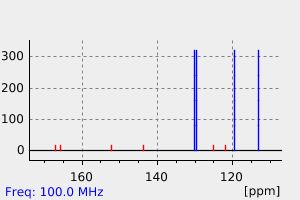4-(4-氨基苯甲酰基氨基)-苯甲酸 | 36711-56-5
中文名称
4-(4-氨基苯甲酰基氨基)-苯甲酸
中文别名
——
英文名称
4-(4'-aminobenzamido)benzoic acid
英文别名
4-(4-aminobenzamido)benzoic acid;4-(4-amino-benzoylamino)-benzoic acid;4-(4-Amino-benzoylamino)-benzoesaeure;4-(4-Amino-benzamino)-benzoesaeure;4-Amino-4'-carboxybenzanilid;4-[(4-aminobenzoyl)amino]benzoic acid
CAS
36711-56-5
化学式
C14H12N2O3
mdl
MFCD00430500
分子量
256.261
InChiKey
WQJFKWNHMPAYNT-UHFFFAOYSA-N
BEILSTEIN
——
EINECS
——
-
物化性质
-
计算性质
-
ADMET
-
安全信息
-
SDS
-
制备方法与用途
-
上下游信息
-
文献信息
-
表征谱图
-
同类化合物
-
相关功能分类
-
相关结构分类
物化性质
-
熔点:>300 °C (decomp)
-
沸点:424.4±30.0 °C(Predicted)
-
密度:1.399±0.06 g/cm3(Predicted)
计算性质
-
辛醇/水分配系数(LogP):1.5
-
重原子数:19
-
可旋转键数:3
-
环数:2.0
-
sp3杂化的碳原子比例:0.0
-
拓扑面积:92.4
-
氢给体数:3
-
氢受体数:4
安全信息
-
海关编码:2924299090
SDS
上下游信息
-
上游原料
中文名称 英文名称 CAS号 化学式 分子量 4-[(4-硝基苯甲酰基)氨基]苯甲酸 4-(4-nitrobenzamido)benzoic acid 19717-14-7 C14H10N2O5 286.244 N-(4-甲基苯基)-4-硝基苯甲酰胺 N-(4-methylphenyl)-4-nitrobenzamide 6917-08-4 C14H12N2O3 256.261 -
下游产品
中文名称 英文名称 CAS号 化学式 分子量 —— 4-[[4-[[4-[(4-Nitrobenzoyl)amino]benzoyl]amino]benzoyl]amino]benzoic acid 851942-92-2 C28H20N4O7 524.489
反应信息
-
作为反应物:描述:参考文献:名称:可溶性低聚芳酰胺前体-一种用于棒材线圈体系结构的新型构建基块。摘要:描述了一种新的合成路线,该路线允许通过形成亚氨酰氯将本来不溶的寡聚对苯甲酰胺可逆地转化为可溶性物质。报道了相应的二聚体,三聚体和四聚体的合成。这些化合物可以很容易地通过结晶纯化,并且可以在数克范围内获得。通过三聚体和四聚体前体的单晶X射线结构获得结构证明。它们可以在末端羧酸基团上选择性地官能化为酰胺或酯,然后将亚氨酰氯水解为母体酰胺。这类新化合物可以在很少的合成步骤中获得强聚集的刚性棒状材料,正如制备聚(乙二醇)-低聚(对-苯甲酰胺)棒-线圈嵌段共聚物所证明的那样。DOI:10.1002/chem.200401085
-
作为产物:参考文献:名称:Bredereck; v. Schuh, Chemische Berichte, 1948, vol. 81, p. 215,220摘要:DOI:
文献信息
-
一种以树状分子为核的分子影像探针及其应 用申请人:东南大学公开号:CN104147619B公开(公告)日:2018-01-16一种以树状分子为核的分子影像探针及其应用,通过在树状分子IV上连接四个刚性手臂分子,并连接不同的功能分子,从而得到低位阻的多模式多靶点的分子影像探针。得到探针稳定性好,显像对比度高。研究合成的分子影像探针,通过连接的靶向分子和信号分子,实现分子影像探针主动靶向至病变部位,通过连接不同的靶向分子,实现其在制备诊疗不同肿瘤类疾病药物中的应用。
-
Hydrogen-Bonded Aggregates of Oligoaramide−Poly(ethylene glycol) Block Copolymers作者:Anne Bohle、Gunther Brunklaus、Michael R. Hansen、Tobias W. Schleuss、Andreas F. M. Kilbinger、Jens Seltmann、Hans W. SpiessDOI:10.1021/ma100501j日期:2010.6.8Rod−coil copolymers with an oligomeric rod aggregate on a nanometer length scale, which is important for many applications like e.g. organic photovoltaics. However, this aggregation behavior and the driving forces such as hydrogen bonding and π−π interactions, as well as the role of side groups, are not yet fully understood. Here, we investigated these noncovalent interactions in oligo(p-benzamide)−poly(ethylene带有低聚棒的棒-螺旋共聚物在纳米级尺度上聚集,这对于许多应用(例如有机光伏)很重要。但是,这种聚集行为和驱动力(例如氢键和π-π相互作用)以及侧基的作用尚未完全了解。在这里,我们调查的寡核苷酸,这些非共价相互作用(p-苯甲酰胺)-聚乙二醇(OPBA-PEG)共聚物,使用固态NMR,并由广角X射线散射(WAXS),差示扫描量热法(DSC)和偏振光学显微镜(POM)支持。发现更长的OPBAs形成分层的β-片状聚集体,并且它们在未取代的OPBAs和OPBA-PEG棒-螺旋共聚物中均通过酰胺氢键稳定。PEG的结合还引入液晶相。结果,改善了共聚物中的局部结构顺序。因此,通过结合不同的结构研究方法,我们能够开发液晶和固态的局部聚集和堆积模型。
-
Acetylene Derivatives申请人:Glatthar Ralf公开号:US20080214673A1公开(公告)日:2008-09-04The invention provides compounds of formula (I) wherein R 1 represents hydrogen or alkyl; R 2 represents an unsubstituted or substituted heterocycle or R 2 represents an unsubstituted or substituted aryl; R 3 represents alkyl or halogen; X represents a single bond or an alkandiyl-group, optionally interrupted by one or more oxygen atoms or carbonyl groups or carbonyloxy groups in free base or acid addition salt form, processes for their preparation and their use as pharmaceuticals.该发明提供了公式(I)的化合物,其中R1代表氢或烷基;R2代表未取代或取代的杂环或未取代或取代的芳基;R3代表烷基或卤素;X代表单键或烷基基团,可选地被一个或多个氧原子或羰基或羰氧基所中断,以自由碱基或酸加成盐形式存在,以及它们的制备方法和作为药物的用途。
-
ACETYLENE DERIVATIVES申请人:GLATTHAR Ralf公开号:US20100099682A1公开(公告)日:2010-04-22The invention provides compounds of formula (I) wherein R 1 represents hydrogen or alkyl; R 2 represents an unsubstituted or substituted heterocycle or R 2 represents an unsubstituted or substituted aryl; R 3 represents alkyl or halogen; X represents a single bond or an alkandiyl-group, optionally interrupted by one or more oxygen atoms or carbonyl groups or carbonyloxy groups in free base or acid addition salt form, processes for their preparation and their use as pharmaceuticals.本发明提供了式(I)的化合物,其中R1代表氢或烷基;R2代表未取代或取代的杂环或R2代表未取代或取代的芳基;R3代表烷基或卤素;X代表单键或者是烷基基团,可以被一个或多个氧原子或羰基或羰氧基所中断,以自由碱或酸加成盐形式存在,以及制备它们的方法和作为药物的用途。
-
[EN] COVALENT CDK2-BINDING COMPOUNDS FOR THERAPEUTIC PURPOSES<br/>[FR] COMPOSÉS DE LIAISON À CDK2 COVALENTS UTILISÉS À DES FINS THÉRAPEUTIQUES申请人:UMBRA THERAPEUTICS INC公开号:WO2022187693A1公开(公告)日:2022-09-09Heteroaryl sulfonyl compounds and compositions that have a CDK2 Recognition Moiety bound to an electrophile for the selective covalent modification of CDK2 to treat CDK2-mediated disorders are described.本文描述了具有CDK2识别基团结合到亲电体的杂环磺酰化合物和组合物,用于选择性共价修饰CDK2以治疗CDK2介导的疾病。
表征谱图
-
氢谱1HNMR
-
质谱MS
-
碳谱13CNMR
-
红外IR
-
拉曼Raman
-
峰位数据
-
峰位匹配
-
表征信息
同类化合物
(βS)-β-氨基-4-(4-羟基苯氧基)-3,5-二碘苯甲丙醇
(S,S)-邻甲苯基-DIPAMP
(S)-(-)-7'-〔4(S)-(苄基)恶唑-2-基]-7-二(3,5-二-叔丁基苯基)膦基-2,2',3,3'-四氢-1,1-螺二氢茚
(S)-盐酸沙丁胺醇
(S)-3-(叔丁基)-4-(2,6-二甲氧基苯基)-2,3-二氢苯并[d][1,3]氧磷杂环戊二烯
(S)-2,2'-双[双(3,5-三氟甲基苯基)膦基]-4,4',6,6'-四甲氧基联苯
(S)-1-[3,5-双(三氟甲基)苯基]-3-[1-(二甲基氨基)-3-甲基丁烷-2-基]硫脲
(R)富马酸托特罗定
(R)-(-)-盐酸尼古地平
(R)-(-)-4,12-双(二苯基膦基)[2.2]对环芳烷(1,5环辛二烯)铑(I)四氟硼酸盐
(R)-(+)-7-双(3,5-二叔丁基苯基)膦基7''-[((6-甲基吡啶-2-基甲基)氨基]-2,2'',3,3''-四氢-1,1''-螺双茚满
(R)-(+)-7-双(3,5-二叔丁基苯基)膦基7''-[(4-叔丁基吡啶-2-基甲基)氨基]-2,2'',3,3''-四氢-1,1''-螺双茚满
(R)-(+)-7-双(3,5-二叔丁基苯基)膦基7''-[(3-甲基吡啶-2-基甲基)氨基]-2,2'',3,3''-四氢-1,1''-螺双茚满
(R)-(+)-4,7-双(3,5-二-叔丁基苯基)膦基-7“-[(吡啶-2-基甲基)氨基]-2,2”,3,3'-四氢1,1'-螺二茚满
(R)-3-(叔丁基)-4-(2,6-二苯氧基苯基)-2,3-二氢苯并[d][1,3]氧杂磷杂环戊烯
(R)-2-[((二苯基膦基)甲基]吡咯烷
(R)-1-[3,5-双(三氟甲基)苯基]-3-[1-(二甲基氨基)-3-甲基丁烷-2-基]硫脲
(N-(4-甲氧基苯基)-N-甲基-3-(1-哌啶基)丙-2-烯酰胺)
(5-溴-2-羟基苯基)-4-氯苯甲酮
(5-溴-2-氯苯基)(4-羟基苯基)甲酮
(5-氧代-3-苯基-2,5-二氢-1,2,3,4-oxatriazol-3-鎓)
(4S,5R)-4-甲基-5-苯基-1,2,3-氧代噻唑烷-2,2-二氧化物-3-羧酸叔丁酯
(4S,4''S)-2,2''-亚环戊基双[4,5-二氢-4-(苯甲基)恶唑]
(4-溴苯基)-[2-氟-4-[6-[甲基(丙-2-烯基)氨基]己氧基]苯基]甲酮
(4-丁氧基苯甲基)三苯基溴化磷
(3aR,8aR)-(-)-4,4,8,8-四(3,5-二甲基苯基)四氢-2,2-二甲基-6-苯基-1,3-二氧戊环[4,5-e]二恶唑磷
(3aR,6aS)-5-氧代六氢环戊基[c]吡咯-2(1H)-羧酸酯
(2Z)-3-[[(4-氯苯基)氨基]-2-氰基丙烯酸乙酯
(2S,3S,5S)-5-(叔丁氧基甲酰氨基)-2-(N-5-噻唑基-甲氧羰基)氨基-1,6-二苯基-3-羟基己烷
(2S,2''S,3S,3''S)-3,3''-二叔丁基-4,4''-双(2,6-二甲氧基苯基)-2,2'',3,3''-四氢-2,2''-联苯并[d][1,3]氧杂磷杂戊环
(2S)-(-)-2-{[[[[3,5-双(氟代甲基)苯基]氨基]硫代甲基]氨基}-N-(二苯基甲基)-N,3,3-三甲基丁酰胺
(2S)-2-[[[[[((1S,2S)-2-氨基环己基]氨基]硫代甲基]氨基]-N-(二苯甲基)-N,3,3-三甲基丁酰胺
(2S)-2-[[[[[[((1R,2R)-2-氨基环己基]氨基]硫代甲基]氨基]-N-(二苯甲基)-N,3,3-三甲基丁酰胺
(2-硝基苯基)磷酸三酰胺
(2,6-二氯苯基)乙酰氯
(2,3-二甲氧基-5-甲基苯基)硼酸
(1S,2S,3S,5S)-5-叠氮基-3-(苯基甲氧基)-2-[(苯基甲氧基)甲基]环戊醇
(1S,2S,3R,5R)-2-(苄氧基)甲基-6-氧杂双环[3.1.0]己-3-醇
(1-(4-氟苯基)环丙基)甲胺盐酸盐
(1-(3-溴苯基)环丁基)甲胺盐酸盐
(1-(2-氯苯基)环丁基)甲胺盐酸盐
(1-(2-氟苯基)环丙基)甲胺盐酸盐
(1-(2,6-二氟苯基)环丙基)甲胺盐酸盐
(-)-去甲基西布曲明
龙蒿油
龙胆酸钠
龙胆酸叔丁酯
龙胆酸
龙胆紫-d6
龙胆紫







